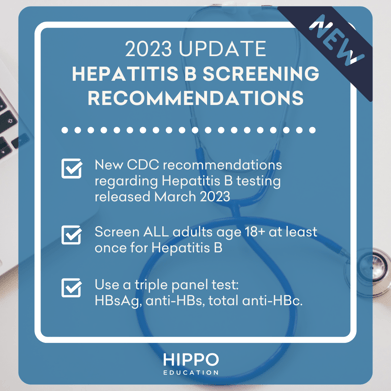New Hepatitis B Screening Recommendations for 2023

We know that chronic hepatitis B infection can lead to substantial morbidity and mortality. While there is no cure, antiviral treatment, monitoring, and liver cancer surveillance can improve outcomes for people living with hepatitis B. Additionally, effective preventative hepatitis B vaccines are available.
Until recently, guidelines recommended that only people at high risk of infection be screened for hepatitis B virus (HBV). Under that policy, we missed a lot of people: only an estimated 1 in 3 people in the U.S. with hepatitis B are aware they are infected.
Who Should be Screened for Hepatitis B Virus, and How Often?
In March 2023, the CDC issued new guidelines recommending expansion of hepatitis B screening to everyone. Under the new guideline, all adults 18 and older should be screened for hepatitis B at least once in their lifetime.
Screening should be done using a triple panel test which includes HBsAg, anti-HBs, and anti-HBc.
The 3-test panel can identify individuals with current HBV infection, those with prior HBV infection, those with immunity due to prior vaccination, and those who are susceptible to HBV and would benefit from vaccination.
If the test is negative and no new risk factors are identified, people don’t need to be screened again. However, people considered at increased risk for HBV should still get periodic repeat testing.
Additionally, all pregnant people should be tested for HBsAg during each pregnancy regardless of vaccination status or history of testing.
Who is at Increased Risk for HBV?
The CDC identifies these groups to be at increased risk for HBV:
- Currently or formerly incarcerated persons
- Persons with current or past STIs or multiple sex partners
- Persons with current or past hepatitis C virus infection
- Persons born in regions with an HBV prevalence 2% or greater
- US-born persons whose parents were born in regions of high HBV prevalence (>8%) and who were not vaccinated as infants
- Persons with HIV infection
- Persons with current or past injection drug use
- Men who have sex with men
- Infants born to people who are HBsAg-positive
- Household contacts of persons with HBV infection
- Needle-sharing or sexual contacts of persons with known HBV infection
- Patients on dialysis
- Persons with elevated ALT or AST levels of unclear etiology
- Persons who request HBV testing (may be due to reluctance to disclose risk factors)
Decisions about the frequency for HBV testing in these high risk groups should be individualized based on risk factors, patient age, and immune status.

For a deeper dive on new hepatitis B screening recommendations for 2023, listen to our most recent segment on the Primary Care RAP podcast. See full chapter summary here.
Practice-Changing Education
Experience education that goes beyond theory. Explore Hippo Education’s offerings below.


